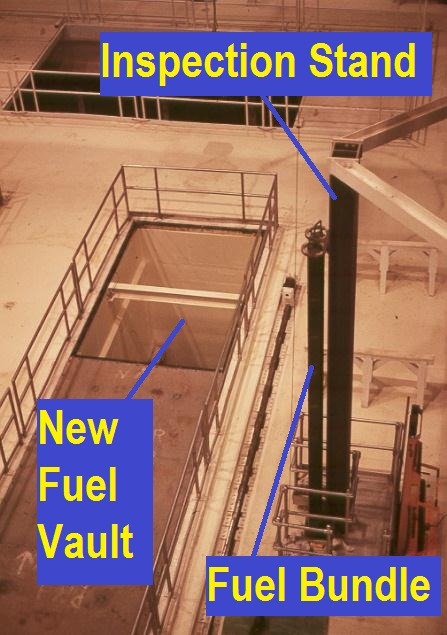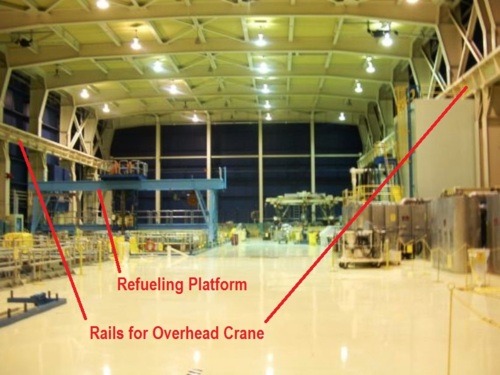 Figure 1
Figure 1
During a refueling outage in December 1979, workers at the Pilgrim nuclear power plant south of Boston (and north, way north, of Miami) transferred new (un-irradiated) fuel bundles into the spent fuel pool. They used the reactor building’s overhead crane to pick up a new fuel bundle from the inspection stand on the refueling floor and lower it into a storage rack in the spent fuel pool.
Figure 1 shows a new fuel bundle in the inspection stand next to the new fuel vault. Figure 2 shows the rails for the reactor building’s overhead crane (the crane itself is on the rails behind the photographer) and the refueling platform that straddles the spent fuel pool and reactor cavity. The refueling platform is used to transfer fuel bundles underwater between the spent fuel pool and the reactor core.
 Figure 2
Figure 2
Workers placed one new fuel bundle into a storage rack and began pulling the crane’s hook out of the spent fuel pool. Suddenly, radiation alarms on the refueling floor sounded. Operators discovered an irradiated fuel bundle at the end of the crane’s hook and quickly returned it to a storage rack.
The new fuel bundle had been placed in a storage rack near an irradiated fuel bundle. The crane’s hook wedged between the lifting bail and fuel channel on the irradiated fuel bundle. The operators did not realize they had snagged an irradiated fuel bundle until it came close enough to the pool’s surface to set off the radiation alarms on the refueling floor.
The refueling platform normally used to transfer fuel bundles in the spent fuel pool and the fuel preparation machine (equipment used to conduct maintenance on and inspections of fuel bundles) mounted on a side wall of the spent fuel pool are designed not to permit a fuel bundle to be raised closer than 8 feet from the spent fuel pool’s surface. This amount of water shields workers from the intense radiation emitted from irradiated fuel bundles.
However, the overhead crane they were using—which is not supposed to move irradiated fuel—could have lifted the spent fuel bundle out of the pool, and would have if they had not stopped as soon as they heard the radiation alarms.
Our Takeway
Using an unbaited hook, workers at Pilgrim nearly managed to land a big one. It’s extremely fortunate they didn’t get a closer look at this one that got away. The radiation levels from an exposed irradiated fuel bundle can cause a fatal dose in mere seconds.
This potentially lethal hazard is precisely why the refueling platform and fuel preparation machine are designed to prevent a fuel bundle from getting too close to the pool’s surface. Of course, these design features afford zero protection when workers use other equipment to move fuel bundles in the spent fuel pool. They should not have used the overhead crane close to irradiated fuel in the spent fuel pool and nearly paid a high price for their mistake.
“Fission Stories” is a weekly feature by Dave Lochbaum. For more information on nuclear power safety, see the nuclear safety section of UCS’s website and our interactive map, the Nuclear Power Information Tracker.
